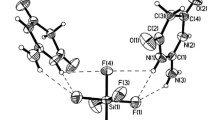Summary
Some salts of tin, titanium, zirconium, hafnium, niobium, tantalum, molybdenum and tungsten can act as mordants which can combine with polysaccharides and their presence can be detected as colored compounds with an acid alcoholic solution of gallocyanin. None of these metals produced color reaction when used alone. Titanium, zirconium, hafnium, niobium, tantalum and tin form a blue gallocyanin color with salivary, laryngeal, bronchial, gastrointestinal, uterine cervical gland mucins, cartilage and rat mast cells. In addition, tin (IV), titanium (IV), hafnium, niobium and tantalum stained Brunner gland bluish violet to a purple. Gallocyanin mordanted with molybdenum and tungsten stained collagen, reticulum and cartilage blue to dark blue. In addition, tungsten stained some elastic fibers a bright red violet. Paneth cells were stained dark blue by niobium, molybdenum and acidified titanium potassium oxalate. Molybdenum could be extracted by alkalis and titanium by strong acids after tissues have been mordanted. Methylation prior to mordanting inhibits staining of the mucosubstances by titanium. Sulfation enhances staining reactions by titanium and molybdenum.
Similar content being viewed by others
References
Bahr, G.F.: Gallocyanin-indiumalum. Electron stains. I. Exp. Cell Res. 5, 551–553 (1953).
Becher, S.: Untersuchungen über die Echtfärbung der Zellkerne mit künstlichen Beizenfarbstoffen und die Theorie des histologischen Farbprozesses mit gelösten Lacken, quoted by Gray, et al. Berlin: Verlag von Gebrüder Bornträger 1921.
Berube, G.R., Powers, M.M., Kerkay, J., Clark, G.: The gallocyaninchrome alum stain; influence of methods of preparation on its activity and separation of active staining compound. Stain Technol. 41, 73–81 (1966).
Beswick, T. S. L.: The Einarson gallocyanin lake staining technique. J. Path. Bact. 76, 598–600 (1958).
Boesekin, J.: The use of boric acid for the determination of the configuration of carbohydrates. Advanc. Carbohyd. Chem. 4, 189–210 (1949).
Einarson, L.: A method for progressive selective staining of Nissl and nuclear substance in nerve cells. Amer. J. Path. 8, 295–308 (1932).
— On the theory of gallocyanin-chromalum staining and its application for quantitative estimation of basophilia. A selective staining of exquisite progressivity. Acta path. microbiol. scand. 28, 82–102 (1951).
Feigl, F.: Spot tests in inorganic analysis, p. 204. New York: Elsevier Publ. Co., Inc. 1958.
—: Spot tests in organic analysis, p. 404. New York: Elsevier Publ. Co., Inc. 1966.
Foster, A. B., Stacey, M.: The chemistry of the 2-amino sugars (2-amino-2 deoxy-sugars). Advanc. Carbohyd. Chem. 7, 247–288 (1952).
Golodetz, L., Unna, P.G.: Zur Chemie der Haut. Mh. prakt. Derm. 48, 149–166 (1909).
Gray, P., Day, M. W., Hayweiser, L. J., Nevsimal, C.: Oxazine dyes. 2. Celestine blue B, gallocyanin and gallamin blue with mordants other than ferric alum. Stain Technol. 32, 161–165 (1957).
Horobin, R. W., Murgatroyd, L. B.: The composition and properties of gallocyanin-chrome alum stains. Histochem. J. 1, 36–54 (1968).
Kiefer, G., Zeller, W., Sandritter, W.: Eine Methode zur histochemischen Bestimmung von RNS und DNS an der gleichen Zelle. Histochemie 20, 1–10 (1969).
Lagerstedt, S.: The quantitative estimation of basophilia through gallocyanin-chromalum staining. Acta anat. (Basel) 5, 217–223 (1948).
Lillie, R. D.: Phenolic oxidative activities of the skin: Some reactions of keratohyalin and trichohyalin. J. Histochem. Cytochem. 4, 318–336 (1956).
—: Histopathologic technic and practical histochemistry, 3rd ed. New York: McGraw-Hill Book Co. 1965.
—: Exploration of dye chemistry in orcein type elastic tissue staining. Histochemie 19, 1–12 (1969a).
—: Mechanisms of chromation hematoxylin stains. Histochemie 20, 338–354 (1969b).
- Donaldson, P., Pizzolato, P.: Difficulties in ferrous iron mordant hematoxylin staining and some hematoxylin substitutes. Stain Technol. (In print).
—, Gutierrez, A., Madden, D., Henderson, R.: Acid orcein-iron and acid orcein-copper stains for elastin. Stain Technol. 43, 203–206 (1968).
—, Pizzolato, P.: Acid alcoholic brilliant cresyl blue stain for gastric and other mucins. Histochemie 17, 138–144 (1969).
—, Stotz, E. H., Emmel, V. M., Darrow, M. A.: Conn's biological stains, 8th ed. Baltimore: Williams & Wilkins 1969.
Mayer, P.: Über Schleimfärbung. Mitt. Zool. Stat. Neapel 12, 303–330 (1896).
Nørrevany, A.: On the mucous secretion from the proboscis in Harrimania kupfferi (enteropneusta). Ann. N.Y. Acad. Sci. 118, 1052–1069 (1965).
Pakkenberg, H.: Gallocyanin-chrome alum staining: A quantitative evaluation. J. Histochem. Cytochem. 10, 367 (1967).
Pedersen, K. J.: Cytological and cytochemical observations on the mucous gland cells of an acoel turbellarian, Convoluta convoluta. Ann. N.Y. Acad. Sci. 118, 930–965 (1965).
Pizzolato, P., Lillie, R. D.: Metal salts-hematoxylin staining of skin keratohyalin granules. J. Histochem. Cytochem. 15, 104–110 (1967).
—: The impregnation of bone and pathologic calcification by metal salts and their recognition by unoxidized hematoxylin. Histochemie 16, 333–338 (1968).
Proescher, F., Arkush, A. S.: Metallic lakes of the oxazines (gallamin blue, gallocyanin and coelestin blue) as nuclear stain substitutes for hematoxylin. Stain Technol. 3, 28–40 (1928).
Reeves, R. E.: Cuprammonium-glucoside complexes. In: Advanc. Carbohyd. Chem. 6, 107–134 (1951).
Sandritter, W., Kiefer, G., Rick, W.: Gallooyanin-chrome alum. In: Introduction to quantitative cytochemistry (ed. G. L. Wild). New York: Academic Press. Inc. 1966.
Stenram, U.: The specificity of the gallocyanin-chromalum stain for nucleic acid as studied by the ribonuclease technique. Exp. Cell Res. 4, 383–389 (1953).
Terner, J. Y., Clark, G.: Gallocyanin-chrome alum: I. Technique and specificity. Stain Technol. 35, 167–177 (1960a).
—: Gallocyanin-chrome alum: II. Histochemistry and specificity. Stain Technol. 35, 305–311 (1960b).
Author information
Authors and Affiliations
Rights and permissions
About this article
Cite this article
Pizzolato, P., Lillie, R.D. The staining of mucopolysaccharides with gallocyanin and metal mordants. Histochemie 27, 335–350 (1971). https://doi.org/10.1007/BF00305336
Received:
Issue Date:
DOI: https://doi.org/10.1007/BF00305336




